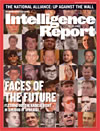Report editor Mark Potok discusses the future of the American radical right and the nation’s leading neo-Nazi group, the National Alliance.
The National Alliance, for decades the nation’s leading neo-Nazi group, is losing money and members — an average of about one a day — and seems bound for still more serious trouble, perhaps even dissolution. The World Church of the Creator, the second most important neo-Nazi organization, has virtually evaporated since its leader was jailed last January on charges of having solicited the murder of a federal judge.
The closest thing the movement has to a celebrity, former Klan leader David Duke, is serving a prison sentence that won’t end until next year.
Is the American radical right collapsing?
It would be easy to conclude that these facts, coupled with a remarkable number of other arrests and additional internal movement problems, are symptoms of the crack-up of the extreme right. But it would also be wrong.
The fact is, the radical right seems to be here to stay. Even as some sectors of the movement founder, other areas — anti-immigrant groups, neo-Confederates, the more genteel “academic racists” and others — are expanding.
The increasing hegemony of multicultural ideology, the political and economic effects of advancing globalization, and a host of other factors have fostered an angry backlash that is helping the movement to grow. In fact, what we are witnessing is the realignment of the radical right — a reshuffling of groups, leaders and causes.
The movement may have taken a hit, but it is not going away.
Making the Point With Violence
This September, the grotesque story of the so-called 311 Boyz, a white gang composed of middle- and upper-class suburban Las Vegas teenagers, helped to emphasize that point. Nine members of the group — whose name is shorthand for KKK (K being the 11th letter of the alphabet) — were charged with attempted murder after allegedly smashing in another teenage boy’s face with rocks. Gang members also chronicled a series of other assaults and fights on a homemade video.
A month earlier, in Derby, Conn., federal agents arrested Raymond DelVecchio after the 54-year-old man allegedly tried to trade guns to an undercover agent from the Bureau of Alcohol, Tobacco and Firearms in return for burning down a house DelVecchio feared would be rented to a black family. Prosecutors have a tape of DelVecchio saying he wanted to hang minorities. A grand jury indicted him on counts of being a felon in possession of firearms and ammunition.
Also in August, three white youths from suburban Long Island, N.Y. — two 16-year-olds and a 17-year-old — were indicted on charges of reckless endangerment and arson. The boys, who could face up to years in prison, allegedly set fire to a home containing a sleeping Mexican family. When they were arrested, one boy had photos of Klan members and anti-Hispanic literature in his pocket.
The home they allegedly firebombed was next to one from where two immigrant day laborers were abducted and beaten nearly to death about three years earlier.
These cases and countless others illustrate the continuing threat posed by right-wing extremism in America. Although those arrested apparently did not belong to larger hate groups, it seems likely that hate propaganda influenced their actions.
In the Long Island case, in particular, both local and national anti-immigrant groups with especially venomous leaders had operated in the area for years, working to build hatred toward Mexicans.
Clues to the Future
Although there is no question that the radical right has experienced a very difficult year, there are real indications that the movement may still be growing. This September, a reported 350 racist Skinheads and others made their way to Harrisburg, Pa., to attend Hammerfest 2003 — a white power music concert put on by the hardest-core Skinhead group around. That number is up sharply from the 150 who attended in 2002 and even the 220 who came to 2001’s production.
In this issue, the Intelligence Report offers some clues as to the shape that the radical right is likely to take in the coming months. A major story documents the dramatically falling fortunes of the National Alliance.
But it is in the profiles of activists and leaders that readers may begin to get a real glimmer of the future. While the list is far from comprehensive, and excludes most of those who are in prison or have been profiled in these pages before, it provides a sense of what is to come.
From Gordon Lee Baum, head of the Council of Conservative Citizens hate group, to Ron Wilson, who is leading an attempted extremist takeover of the Sons of Confederate Veterans heritage group, the people described in this issue are key players on the radical fringes of the American body politic. If we carefully study these men and women, distasteful as that may be, we may all be better equipped to understand and cope with the threat they present to the rest of us.



